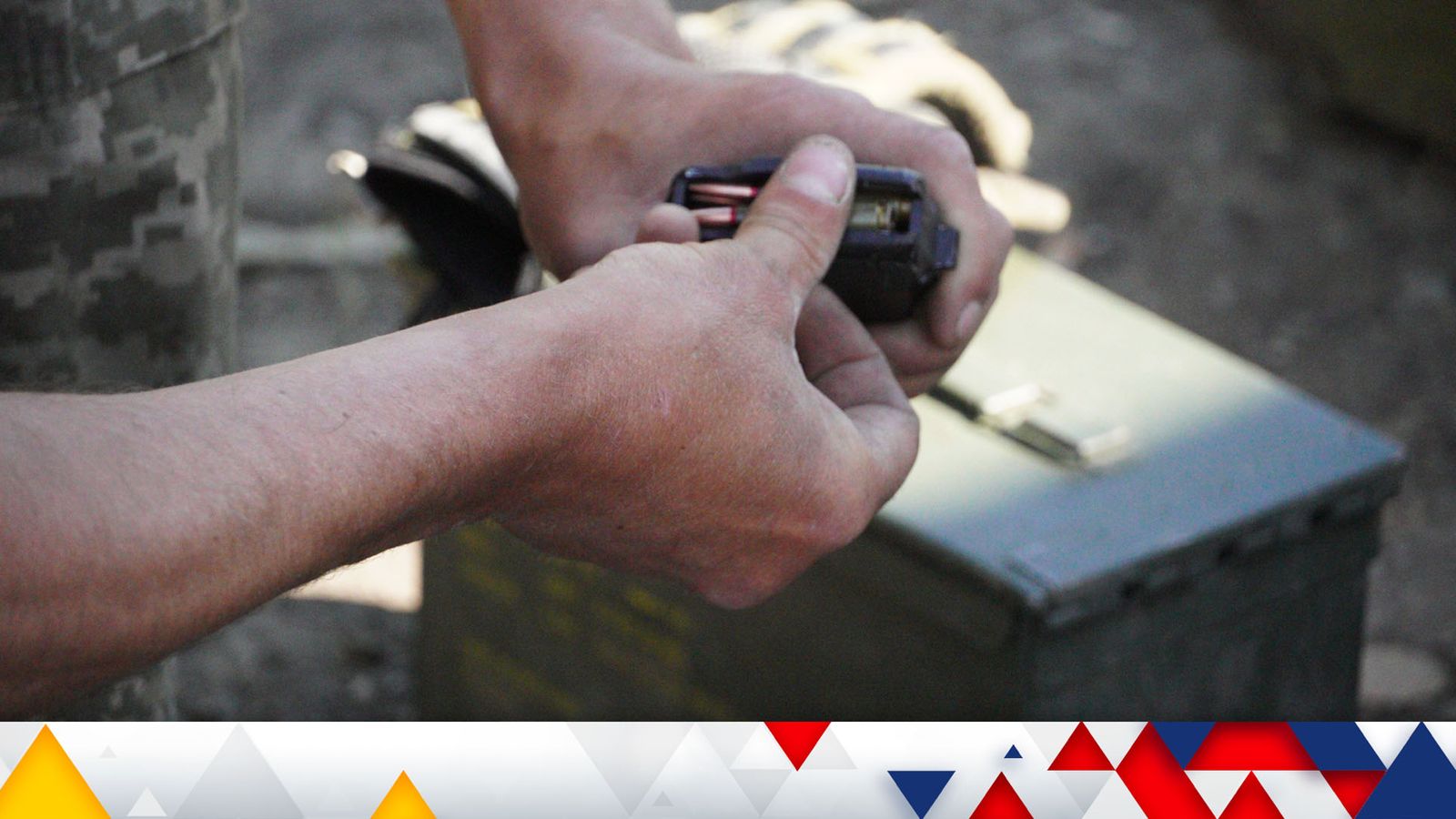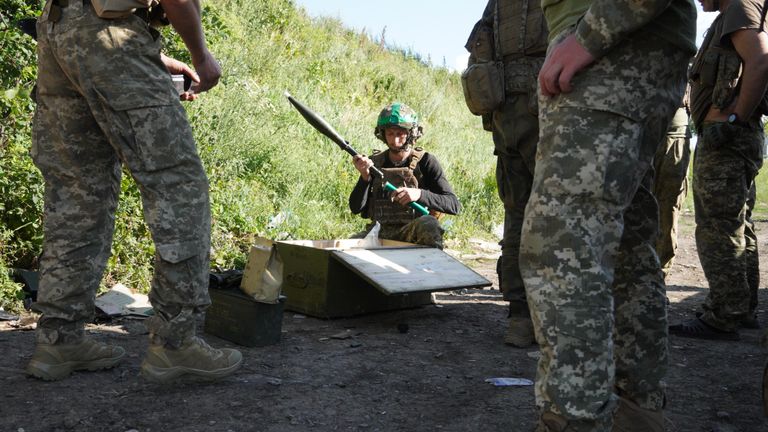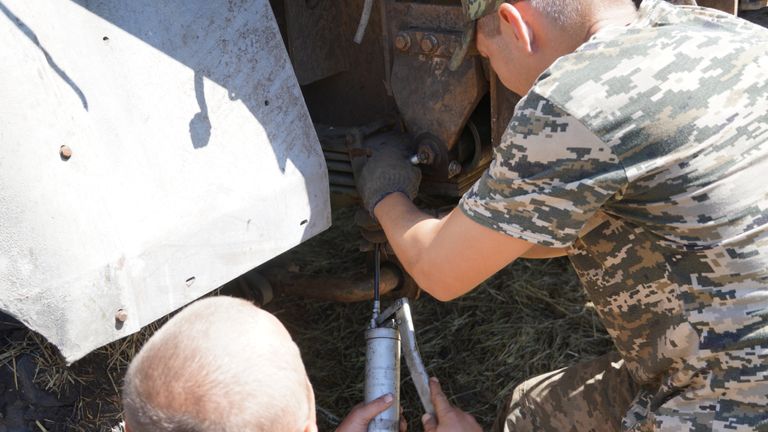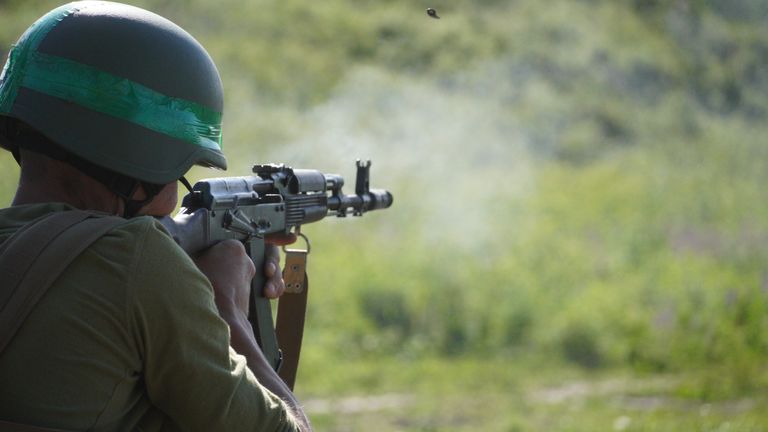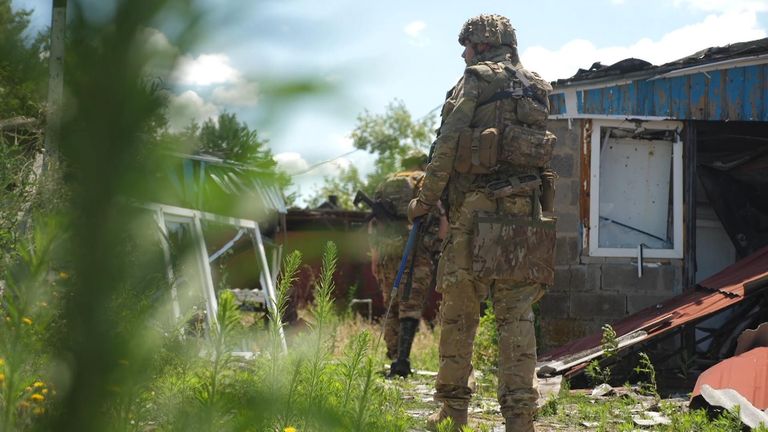For the members of the demining unit in Ukraine’s 35th marine brigade, every step is fraught with peril – every action is beset with risk – during a period that has been particularly dangerous.
As the Ukrainians press with their summer offensive, the Russians have countered with Soviet-era tactics. They have laid millions and millions of landmines.
Territory and communities along the 1,000km (621 mile) frontier have been saturated with anti-personnel mines, anti-vehicle and anti-tank mines, and remotely-detonated mines.
Some mines are buried, others fired from rockets – some are “victim-activated” booby traps.
All are designed to maim or kill.
Ukraine war – click here for latest updates
Together they constitute what may be the world’s largest minefield and we were told by members of the 35th marine brigade that the Russians are clever when they use them.
Deminers ‘Zeus’ and ‘Constantine’ told us that they have discovered mines and booby traps hidden in gates, doors, cars, cellars and the magazines of automatic weapons. They have even defused booby traps attached to dead bodies.
We found the pair in the back garden of a bombed out house in the village of Vremivka, just a few miles from the frontline.
One searched with a metal detector while the other stood guard with an automatic weapon.
After 10 minutes or so, the pair would switch.
It was something we tried to ask them about but the interview was interrupted by a series of colossal bangs. The Russians were targeting the area with bombs and rockets.
“They’re hitting us, the Russians,” said Zeus. “F***-you, Putin,” he added.
Discovering – and disarming landmines – is a hazardous business but people like Zeus and Constantine face an additional challenge. They have to carry out their duties while they are being shelled and shot at.
“Well, when we’re doing our work the enemy will attack us. The enemy fires at us with their mortars and tanks. But the deminers are the first to go in.”
As the Russians hunker down in their defensive positions, the Ukrainians have been sending in small groups of Ukrainian troops to assault their trenches.
In many cases, these “storming” units are led by the deminers who attempt to chart a path through the mines.
Currently, these missions are conducted on foot after advanced western weaponry, like Leopard tanks and Bradley fighting vehicles, were immobilised in the first two weeks of the counter offensive.
American and British officials say that as much as 20% of the weaponry sent to the battlefield was destroyed in these engagements.
“It’s dangerous, isn’t it?” I asked Constantine.
“Of course. It’s (scary), nerves, but this is our work.”
“What are you wearing on your jacket?” I asked.
“This is my amulet,” he said, grabbing a small angel-shaped doll. “This angel always with me in the fight. In (my) work. I don’t remove it from my body chest. It was given (to me) by wife.”
We watched Zeus and Constantine tackle a TM 62 anti-tank mine that had been partially buried on a grassy verge in Vremivka.
The device, packed with nine kilograms of explosives, would knock a battle tank off its tracks. “If you are coming by car, it will be completely destroyed,” said Constantine. “Also, everybody inside.”
Worried that the Russians had hidden other munitions under – or around – the TM 62, the pair kept their distance, dragging the device into the road with a long rope.
After inspecting it, they took it to a nearby field where they could safely detonate it.
‘I couldn’t feel my leg – I thought I’d just torn it’
The threat had been dealt with – but the pair know that their missions don’t always go to plan.
Last October, Zeus stepped on a landmine as his unit tried to avoid an enemy tank in the region of Kherson.
The munition blew off his right foot and lower right leg. He now wears a camouflage-coloured prosthesis.
“I didn’t realise that I’d lost my leg. I couldn’t feel my leg – but I thought that I’d just torn it a little bit,” he said.
Read more:
What life is like in recaptured Ukrainian territory
Why things are not back to ‘normal’ for Russian border towns
In an interview that was devoid of self-pity, the 25-year old said his only thought was about returning to his unit.
“What did you think when you saw your leg?” I asked.
“I said, give me a prosthesis, I’m going back to battle.”
“Really? You thought right, I’ll go back?
“I did and I came back after five months.”
“How did the unit greet you when you came back?” I asked.
“They were hugging me. Everyone was shocked because it was such a short period of time. You can’t tell that I’m on a prosthesis. They were all excited.”
His story is a reminder that missions can – and do – go wrong.
Ukraine does not release casualty figures, but analysts think that thousands of Ukrainian personnel have been injured or killed by Russian mines.
Zeus is not looking back, however.
“It was hard at first (but) now I have an artificial leg. There are pros and cons of course, many pros, like no nails to cut, no pain, you can step on it, beat it. I can even shoot it,” he said, with a chuckle that turned into a hearty laugh.
